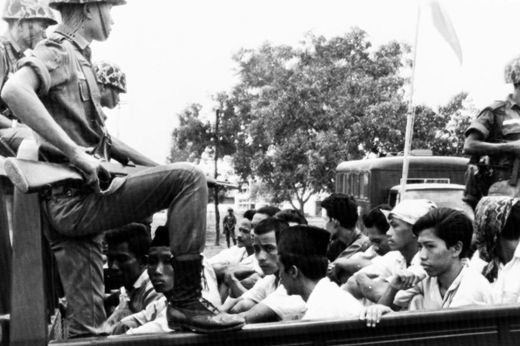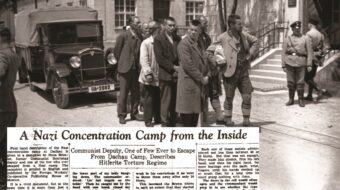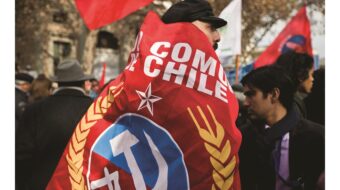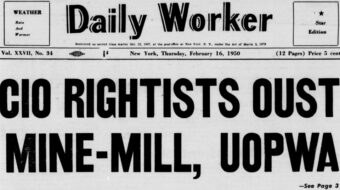
Fifty years ago, the Indonesian killings of an estimated more than 500,000 people in an anti-communist purge had risen to its height. The massacre, following a failed coup of the 30 September Movement, led the country into a “New Order” and the elimination of the Indonesian Communist Party (PKI) as a political force. The upheavals led to the downfall of President Sukarno and the commencement of Suharto’s 30-year presidency.
The failed coup released pent-up communal hatreds which were fanned by the Indonesian Army, which quickly blamed the PKI. Communists were purged from political, social, and military life, and the PKI itself was banned. The massacres began in October 1965 and continued for the next several months into early 1966 throughout the archipelago nation. Thousands of local vigilantes and army units killed actual and alleged PKI members.
Sukarno’s balancing act of “Nasakom” (nationalism, religion and communism) unraveled. His most significant pillar of support, the PKI, had been effectively eliminated by the other two pillars – the army and political Islam; and the army was on the way to unchallenged power. By 1967, Sukarno was stripped of his remaining power by Indonesia’s provisional Parliament, and Suharto was named Acting President. In March 1968, Suharto was formally elected president.
The killings are skipped over in most Indonesian history books and have received little introspection by Indonesians. Anti-communism remained a hallmark of Suharto’s regime.
Under his rule, a film supporting the New Order’s version of events, Pengkhianatan G30S/PKI (Betrayal of Indonesia Communist Party), was broadcast annually on the government television station, the only version of events allowed in open discourse in the country.
U.S. and western complicity
Despite a consensus at the highest levels of the American and British governments that it would be necessary “to liquidate Sukarno,” as related in a CIA memorandum from 1962, and the existence of extensive contacts between anti-communist army officers and the U.S. military establishment (including the training of over 1200 officers, “including senior military figures,” and also providing weapons and economic assistance), the CIA denies active involvement in the killings. It was later revealed that the American government provided extensive lists of communists to Indonesian death squads. A top-secret CIA report stated that the massacres “rank as one of the worst mass murders of the 20th century.”
By the early 1960s, the PKI had approximately 300,000 cadres and a full membership of around two million. It was the third-largest communist party in the world. The party’s assertive efforts to speed up land reform frightened those who controlled the land and threatened the social position of Muslim clerics. Sukarno required government employees to study his Nasakom principles as well as Marxist theory. Sukarno had met with Zhou Enlai, leader of the People’s Republic of China, and accepted Chinese assistance in establishing a revolutionary militia, called a Fifth Force. At a Non-Aligned summit meeting in Cairo (October 1964) he stated his goal to move Indonesian politics leftward and thereby neutralize the reactionary elements in the army that could be dangerous to his newly independent country.
On the evening of 30 September and 1 October 1965, six generals were killed by a group calling itself the 30 September Movement, and Suharto, a senior general, assumed control of the army. He immediately blamed the coup attempt on the PKI. A mass campaign of fabricated claims against Indonesian “heroes” followed, serving to justify a rampage against the left, reformists, non-believers and dissidents. The ensuing massacre was arbitrary, violent, sadistic, and even cannibalistic to an extent. Rivers ran crimson with blood as corpses floated down to the sea. Sukarno protested the purge, stating that the army was “burning down a house to kill a rat.”
From 1958 to 1965 the U.S. trained, funded, advised, and supplied the army precisely so that it could turn itself into a state within a state. The army gradually made itself the government-in-waiting, waiting for an incident like the 30 September movement to occur. They were busy creating the conditions for it and preparing themselves for dealing with it.
According to U.S. Cold War policy, all nationalist leaders of underdeveloped countries who wished to remain neutral were regarded as Communist stooges. The U.S. made a habit of using CIA covert operations to overthrow such leaders: Mossadegh in Iran and Arbenz in Guatemala in 1954, and Souvanna Phouma in Laos in 1960. Sukarno was yet another such leader targeted for removal.
In some places Chinese-owned shops were destroyed and their owners killed, which contributed to the subsequent distracting myth that the massacre was basically a spontaneous, genocidal “race riot.” But few Chinese Indonesians were PKI members. The best estimate is that around 2000 Chinese Indonesians were killed, out of a total death toll of 500,000.
The British ambassador, Andrew Gilchrist, wrote to London: “I never concealed from you my belief that a little shooting in Indonesia would be an essential preliminary to effective change. News of the massacre was carefully controlled by Western intelligence agencies. Journalists, prevented from entering Indonesia, relied on the official statements from Western embassies. Australian Prime Minister Harold Holt commented in the New York Times, “With 500,000 to 1 million Communist sympathizers knocked off, I think it is safe to assume a reorientation has taken place.” The right-wing oilman H.L. Hunt proclaimed Indonesia the sole bright spot for the U.S. in the Cold War and called the ouster of Sukarno the “greatest victory for Freedom since the last decisive battle of World War II.” Time magazine described the suppression of the PKI as “The West’s best news for years in Asia,” praising Suharto’s regime as “scrupulously constitutional.”
Robert F. Kennedy was one of the only prominent Americans to condemn the massacres. In January 1966 he said: “We have spoken out against the inhuman slaughters perpetrated by the Nazis and the Communists. But will we speak out also against the inhuman slaughter in Indonesia, where over 100,000 alleged Communists have not been perpetrators, but victims?”
The USSR’s Andrei Sakharov called the killing a “tragic event” – “an extreme case of reaction, racism and militarism.” Other socialist countries registered strong protests. Only communist Albania objected when Suharto returned Indonesia to the United Nations.
Since declassified documents confirm U.S. and other western government complicity in this singular episode of mass murder. In late 1968, the National Intelligence Estimate for Indonesia reported: “An essential part of the Suharto government’s economic program…has been to welcome foreign capital back to Indonesia. Already about 25 American and European firms have recovered control of mines, estates, and other enterprises nationalized under Sukarno. Liberal legislation has been enacted to attract new private foreign investment…. There is substantial foreign investment in relatively untapped resources of nickel, copper, bauxite, and timber. The most promising industry…is oil.”
The 1982 film The Year of Living Dangerously is based around events leading up to the killings. Adi Zulkadry, a death squad leader during that time, is quoted in Joshua Oppenheimer’s 2012 documentary film The Act of Killing, describing several horrific methods of killing people. “We were allowed to do it. And the proof is, we murdered people and were never punished.” Oppenheimer places the number of deaths between 1 and 3 million people. His companion piece The Look of Silence follows one grieving family trying to understand why it happened and exposes how those behind the Indonesian genocide still revel in their crimes 50 years on.
Adapted from Wikipedia.
Photo: Members of the Indonesian Communist Party’s youth wing are taken away in 1965, during the violent repression of communists in the country. AP

MOST POPULAR TODAY

High Court essentially bans demonstrations, freedom of assembly in Deep South

UN warns that Israel is still blocking humanitarian aid to Gaza

Resource wars rage in eastern Congo, but U.S. capitalism only sees investment opportunity

U.S. imperialism’s ‘ironclad’ support for Israel increases fascist danger at home







Comments